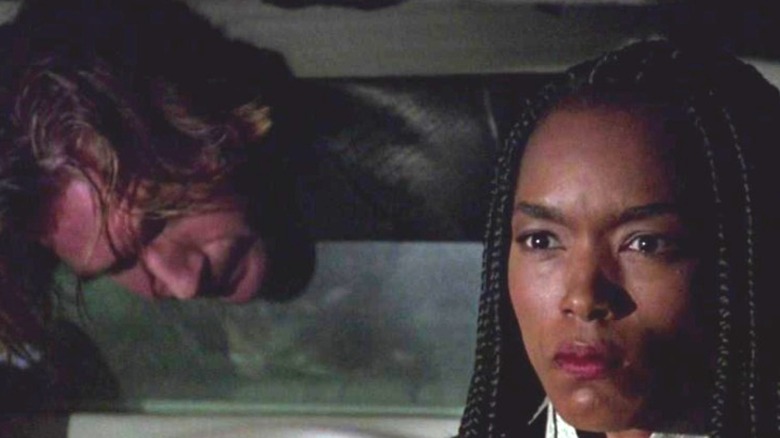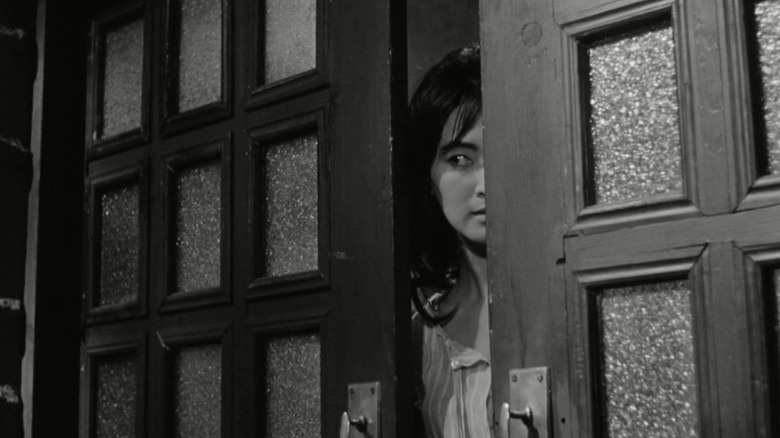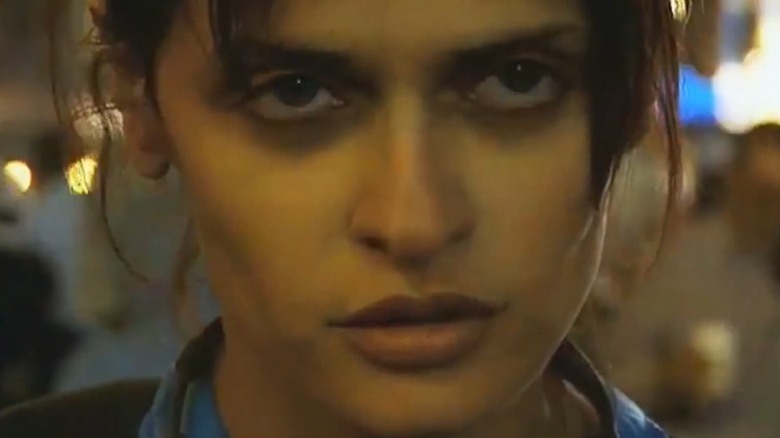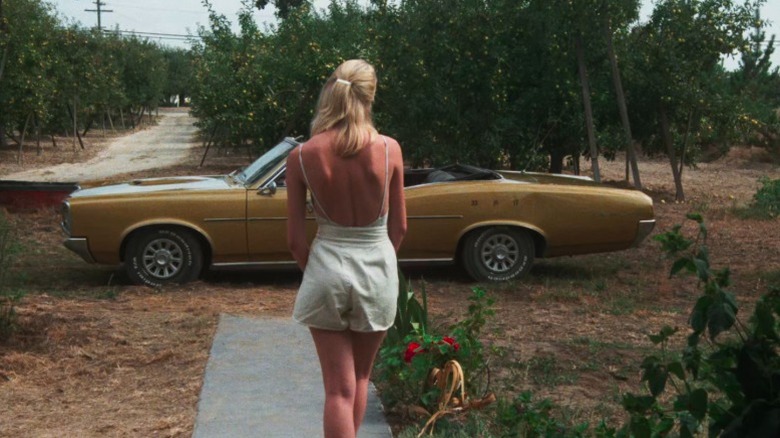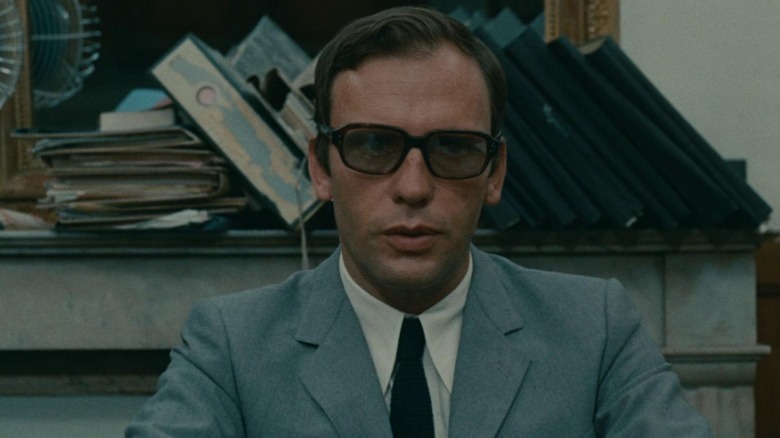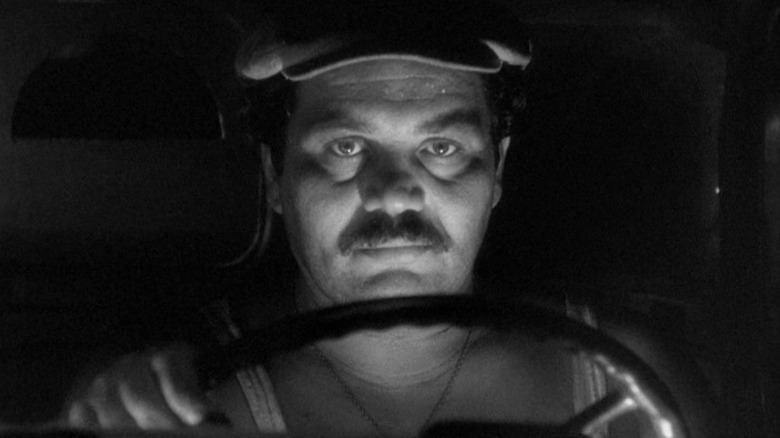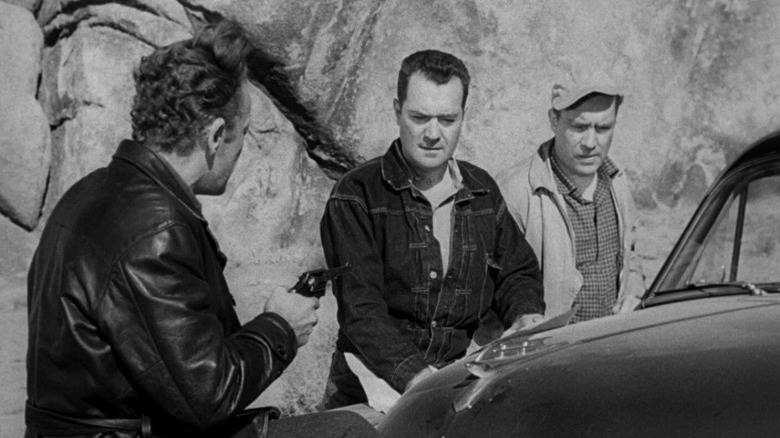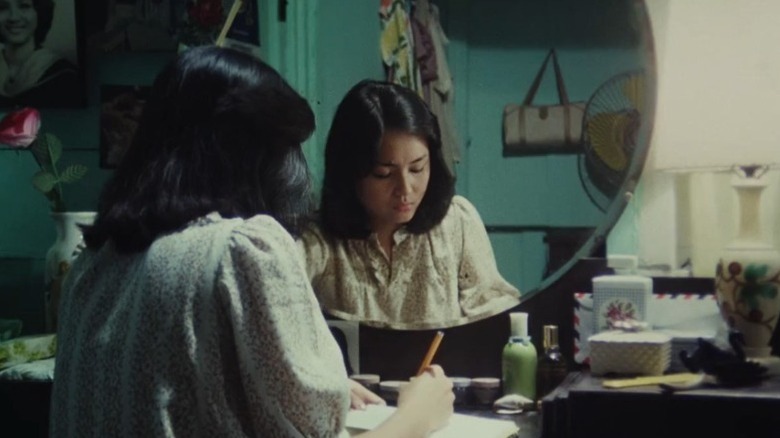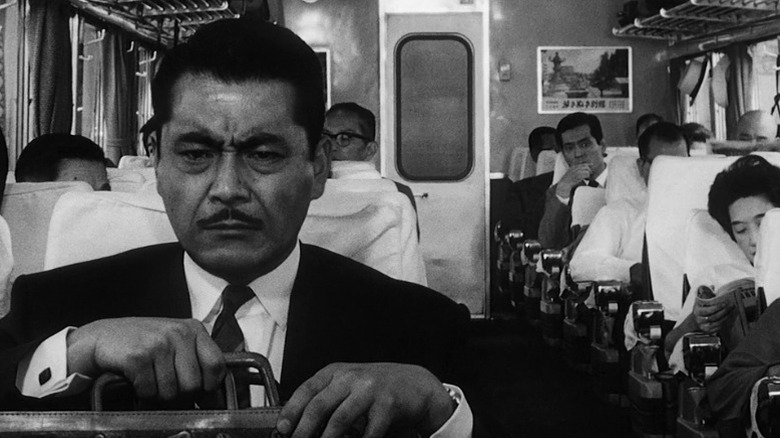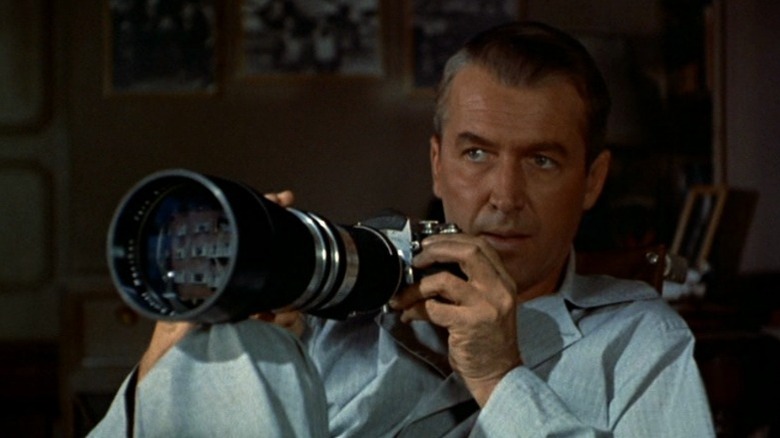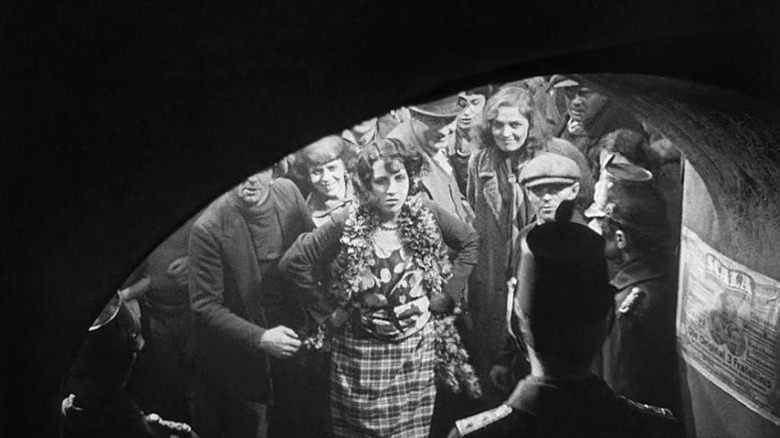The 12 Best Suspense Movies Of All Time, Ranked
If all the best movies know how to play on the audience's worries and expectations, then the task of creating a ranking of all-time great thriller movies is a particularly daunting one. What, after all, even defines a thriller, beyond the customary adherence to the baseline tenets of holding a viewer captive? And, what's more, even if you do manage to set a definition for yourself, what determines the greatness of a thriller — its overall success as a movie, or just its efficiency at eliciting tension?
This ranking endeavors to split the difference by looking not just at the best thrillers of all time, broadly speaking, but at the best works of suspense in the Hitchcockian sense — which is to say, the best movies that take it as a primary goal to wring your nerves to the breaking point. From politicians to serial killers to aggrieved patriarchs, and from 1931 to 2006, here are the best suspense movies of all time.
12. Strange Days
Directed by Kathryn Bigelow in her strongest outing ever as a pure stylist of mood and movement, "Strange Days" epitomizes the singular, apocalyptic anxiety of the '90s paranoia thriller. It's a movie that works perfectly as an exercise in white-knuckle tension, with sequences that find Bigelow putting her generational command of stress and release in service of inventive, multi-layered set pieces and action sequences. But what makes it extraordinary is the way it incorporates worldly, universal suspense — the kind that doesn't wear off once the movie is over — into the very fabric of its storytelling.
In the original, highly prescient screenplay by James Cameron and Jay Cocks, Los Angeles has been pushed to the brink of societal collapse by the year 1999, and the dystopian landscape of the final days before the turn of the millennium is marked by the prominence of SQUID — an illegal device that records the wearer's memories and allows others to experience them. Former LAPD officer Lenny Nero (Ralph Fiennes) makes a living trading SQUID recordings on the black market; one day, following a series of grisly murders, he and his business acolytes (including Angela Bassett as an unspeakably cool limousine driver) get pulled into a dense web of conspiracy and danger. Bigelow balances it all — the murder mystery, the grimy digital horror, the sociological subtext, the elaborate POV sequences, the hovering sense of depersonalization — with a ringmaster's deftness and an innovator's vision.
11. The Housemaid
"The Housemaid" is a film that understands emotional tension as the true core of cinematic suspense, and makes a bigger, rowdier, more nerve-frying meal out of it than almost any other movie in history. One of Bong Joon-ho's favorite films and a self-evident influence on "Parasite," this 1960 Kim Ki-young film is an enduring classic of South Korean cinema, and a global landmark in the domestic thriller genre. Tellingly, it's also an unimaginably intense psychosexual melodrama, with both genres blending into each other so forcefully and productively that they add up to an unclassifiable whole.
In Kim's rigorous, carefully-mapped mise-en-scène, explosive interpersonal calamity is the most powerful fuel there is for guttural dread and uncertainty. Like a master chemist, he places a group of unstable characters within a highly unstable dynamic, and then makes us watch between our fingers as we wait for the whole thing to inevitably go up in flames. Kim Jin-kyu and Ju Jeung-ryu play the Kims, an upper-middle-class Korean couple who have just moved into a bigger, roomier house with their two children. The wife is very pregnant and the husband is busy with his work as a piano teacher, so they hire a housemaid (Lee Eun-shim) to take over housekeeping duties. Soon enough, the housemaid starts behaving in strange, startling ways that threaten to unravel the Kims' entire existence — and Kim adroitly captures her power as a destabilizing force within the very institution of the traditional Korean nuclear family.
10. Day Night Day Night
Perpetually underrated Russian-American auteur Julia Loktev made one of the most unbearably stressful thrillers of all time in 2006 — and, in veritable Bressonian fashion, she did it all within the confines of a pared-down, minimalistic style that's wholly unlike anything else in 21st-century U.S. cinema. In "Day Night Day Night," Luisa Williams plays an unnamed 19-year-old girl who, for utterly opaque reasons, is preparing to carry out a suicide bomb attack in the middle of Times Square. Loktev follows 48 hours in the girl's life, with the film's first half focusing on her boot-camp-esque training, while the second half goes out into the New York streets to chart the act itself.
The fact that no context is given as to who the girl is and why she's doing what she's doing only makes "Day Night Day Night" more singularly stomach-churning. Loktev is interested in the psychology, the procedural banality, and the sheer loneliness of it: Abstracting the inhuman horror of what she's about to do, the girl is a quivering mess of nerves struggling to commit to an overwhelmingly difficult task, facing pressures we don't know but understand to be tremendous, surrounded by a crowd that only compounds her profound sense of isolation. It's grueling stuff even before you factor in that there's a bomb about to go off at any moment, and Loktev's exactingly crude camera gives it all the feeling of a waking nightmare.
9. A Man Escaped
Speaking of Robert Bresson, if you want a case study in how his ascetic filmmaking method revolutionized the way directors conceived of cinematic suspense and went about rattling an audience, there's no better place to look than the filmography of the man himself, and no better example than 1956's "A Man Escaped."
The closest Bresson came to an "accessible" film in his fully-blossomed period, "A Man Escaped" is a perfect war movie — and a prison breakout thriller pared down to essential, elemental gestures. Fontaine (François Leterrier) is a French Resistance member who gets captured by the Nazis and taken to Montluc prison in 1943. He then sets about finding a way out of the strongly-guarded compound before he's executed by the Gestapo.
You know he's getting out because of the title, and Bresson isn't interested in any artificial subterfuges to produce more uncertainty or "higher stakes." He just shows Fontaine scanning the prison's workings, enduring its daily brutality, coming up with a plan, and then carrying it out, step by risky step; the movie has a clarity of purpose and a process-oriented purity that make Fontaine's mission feel almost ASMR-like. And yet, paradoxically, because of the way Bresson guides our attention and holds us captive in his structuring of time and space, it's all unfathomably tense. No other thriller in history gives such a spiritual, physically jolting charge to the mere necessity of escaping confinement and staying alive.
8. Smooth Talk
Sometimes, suspense is about playing with viewers' expectations, lulling them into a false sense of security before pulling up the curtain to reveal that they have been trapped in a cage. As far as that method goes, you won't find a film where the dread hits with more force than in "Smooth Talk," Joyce Chopra's 1985 feminist masterpiece about the horrors of a world where young women are continually stranded in a sea of violence.
A purposeful, deeply intelligent film that marked Chopra's long-awaited debut in fiction film after decades of documentary work, "Smooth Talk" uses its own bait-and-switch structure as a commentary on the ways patriarchal society contaminates and mystifies the emotional development of teenage girls, confounding them with illusory promises that ultimately leave them more vulnerable to danger. Laura Dern stars as Connie Wyatt, a suburban 15-year-old itching to get out from under the thumb of her mother Katherine (Mary Kay Place) and explore her blooming sexuality.
In her exploits out and about in the world, Connie crosses paths with Arnold Friend (Treat Williams), a seemingly charming and kind young man to whom there's more than meets the eye. Then, following a first half that seems to promise John Hughes-esque wistful teen drama, "Smooth Talk" erupts into a queasy, borderline horror-esque calamity that feels as distressing and nightmarish to watch as anything in the medium's history.
7. Z
A good political thriller can work on the viewer's nerves like no other thriller subgenre. There's something atavistic about that sense of enormity, of great danger enveloping and closing in on characters through an entire system of power and monopolized violence — indeed, it's arguably the kind of thriller that's hardest to shake off one's bones after the credits roll. And the greatest, most relentless political thriller of all time is Costa-Gavras' "Z."
Set in an unspecified Mediterranean country patterned after the junta-controlled Greece of 1967-1974, "Z" was expressly conceived by Costa-Gavras as a political protest, and shot in Algiers, Algeria with a mostly French cast and crew. This allowed the then-exiled Greek filmmaker to tackle the political situation of his home country in real time, with an urgency seldom paralleled in film history. Based on the real-life assassination of Grigoris Lambrakis in 1963, the plot follows the efforts of a magistrate (Jean-Louis Trintignant) to get to the truth of things when an anti-war politician (Yves Montand) is killed in broad daylight, leading to a government cover-up that in turn evinces a dense state conspiracy.
As interested in emotional persuasion as he is in making a statement, Costa-Gavras structures the ensuing saga of popular revolt as a nonstop thrill ride, so fraught with peril and tension as to be "almost intolerably exciting," as Pauline Kael famously put it. Yet the clear-eyed bleakness of his political perspective makes "Z" as harrowing and hard-hitting as it is entertaining.
6. The Wages of Fear
If ever there was an enduring classic of world cinema that achieved its reputation through a mastery of tension and anxiety, it was "The Wages of Fear." Henri-Georges Clouzot's 1953 masterpiece follows four European men stranded in the poor South American town of Las Piedras, surrounded by desert and financially unable to leave. When the tyrannical American oil company that effectively controls Las Piedras offers them $2,000 to take on a job too dangerous for unionized workers, they cannot say no, so they set out to carefully transport a load of nitroglycerin through the jungle in order to extinguish a massive oil field fire.
Every millimeter of the four men's trek is laden with sweaty, breathtaking danger, and Clouzot's spare yet expressionistic style maximizes their ordeal into a kind of hallucinatory purgatory; there is nary a shot in the film that doesn't come with its own heart-pounding charge. It's one of the most overpowering feats of filmmaking in history, and Clouzot puts it in service of a bracingly brilliant conceptual project: The longer "The Wages of Fear" wears on, the clearer it becomes that capitalism itself is the hell at hand. Just make sure you avoid the Netflix remake.
5. The Hitch-Hiker
A landmark of American indie cinema, 1953's "The Hitch-Hiker" whittles down the whole compendium of film noir and thriller cinema to a single, key component which it then makes its entire dramatic thrust: the threat of a gunshot. That looming possibility, so abstract and yet so menacingly physical and absolute, is all it takes for director Ida Lupino to fill the taut 71-minute runtime with constantly escalating dread.
Lupino's film follows Roy Collins (Edmond O'Brien) and Gilbert Bowen (Frank Lovejoy), two friends on a fishing road trip from California to Mexico. Shortly after crossing the border, they pick up a hitchhiker, who turns out to be fugitive serial killer Emmett Myers (William Talman). By simply pointing a gun at the two friends, Myers is able to force them to assist in his escape plan — and so begins a taut three-person play set within the liminal, paradoxical space between the claustrophobia of a small sedan and the vast openness of the Baja California desert.
The only woman director to work consistently in Hollywood in the 1950s, Lupino was a maverick in every sense, and "The Hitch-Hiker" finds her turning the screws of noir for maximum pressure in order to get at something fundamental about the very nature of American masculinity. By imparting an unusually vivid and vulnerable humanity onto her two leads, she makes that car feel every bit as suffocating for us as it does for them.
4. Kisapmata
Sometimes translated as "In the Wink of an Eye," 1981's "Kisapmata" blasted through the 1980s global film landscape like a powder keg. Depending on where you check, it's variously categorized as a family drama, a crime thriller, a psychological horror movie, or a genreless, unclassifiable experiment in sheer unease. What can't be argued is its effectiveness as a piece of cinema — or its staying power as a commentary on Philippine society.
Adapted from a true crime news story by Quijano de Manila, Mike de Leon's film dramatizes the real-life case of a retired policeman who murdered his entire family. Far from merely sensationalizing the violence, however, de Leon and his co-writers Clodualdo del Mundo Jr. and Raquel Villavicencio find in the home of the fictionalized Tatang Dadong Carandang (Vic Silayan) a tightly-wound microcosm for the entire system of patriarchal, state-sponsored oppression of Ferdinand Marcos' rule.
Dadong's daughter Mila (Charo Santos) gets pregnant and marries Noel (Jay Ilagan), and Dadong forces them to stay under his roof. From there on out, the system of domestic domination by which Dadong lives his life begins to unravel for the very first time. De Leon is merciless in charting the reiteration of repression and brutality with which Dadong responds to his daughter's newfound defiance; in examining that slow-motion trainwreck as it barrels to its dreadfully inevitable conclusion, "Kisapmata" proves as tough to watch as it is impossible to stop watching.
3. High and Low
While 1963's "High and Low" is not quite as seismically iconic as the likes of "Seven Samurai," "Rashomon," and "Ikiru," there's no way to watch it without thinking it just might be Akira Kurosawa's best — which should tell you something about what an achievement it is. On top of that, it's just one of the tensest, most unflaggingly precise thrillers ever made.
A seasoned master by the time of its making, Kurosawa brings every bit of his unparalleled formal brilliance to the tale of a police chase for an abducted child, creating one of the purest expressions ever of film as suspense-laden movement through architecture. The setup alone is a work of genius: A businessman (Toshiro Mifune) is finalizing a high-risk buyout of a shoe company when the son of his chauffeur (Yutaka Sada) is mistakenly abducted instead of his own; the kidnappers demand a ransom that, if met, will essentially ruin the businessman's entire life.
Starting from a moral dilemma imbued with built-in anxiety, Kurosawa doles out, bit by bit, the most thoughtfully-structured and expertly modulated procedural tale in movie history. The literal high-low movement between the lush Gondo household and the chaotic Yokohama streets is deployed to create a massive diorama of Japanese postwar society, in all its vicious moral and economic contradictions, and watching it come to life feels like gaining access to a deeper understanding of what movies are capable of.
2. Rear Window
No one ever got the gist of cinema quite like Alfred Hitchcock, and, in "Rear Window," he gets the gist of the gist — which is to say, he takes his own highly efficient principles for producing and sustaining cinematic suspense and compresses them to their rawest, fullest, most vivacious possible expression. If all prior and subsequent Hitchcock movies understood the tension of movie-watching as a voyeuristic interplay — a volatile negotiation between the pleasure of seeing and the fear of seeing too much — then "Rear Window," with its revolutionary storytelling done entirely through the view of a single apartment window, is the moment in cinema history where the medium's voyeurism comes fully to fruition.
L.B. "Jeff" Jefferies (James Stewart) is watching his neighbors from the confines of his wheelchair, and his girlfriend Lisa (Grace Kelly) and nurse Stella (Thelma Ritter) are watching him watch, and we're watching them watch him. When Jeff begins to suspect a murder has occurred, the possibility reverberates through the chain of watchers all the way to a primal tingle in our spines: This is cinema seen as well as lived. It's the most formally elegant and irresistibly jolting chiller the Master of Suspense ever made, because it knows that the distance imposed by the process of watching only compounds the secret fear-slash-hope of feeling the danger leap out of the screen. Not for nothing, it also perfectly embodies the anxieties of 2025.
1. M
It is inconceivable that Fritz Lang made "M" in 1931. At a time when most filmmakers were still struggling to figure out how to best deploy cinematic sound, it's impressive enough that the Austrian master did them all one better and worked out a mature, unprecedented use of cinematic silence. That he did it while laying the groundwork for every serial killer thriller you've ever seen — a decade before film noir, no less — is outright mind-boggling.
But never mind those historical superlatives: Just watch "M," and bask in the perfection of Lang's nerve-racking design of the ultimate murder mystery. Armed with a dynamic, omniscient camera that hovers over the Berlin night in haunted close-ups and astonishingly expressive chiaroscuro compositions, Lang charts the social mayhem that unfolds when the fruitless, endless hunt for a child-killing serial murderer prompts the city's criminal underworld to start their own investigation.
With little emphasis on particular characters or "plot lines" save for the eventual tortured predicament of the killer himself, "M" keeps a simultaneously ice-cold and gut-wrenchingly sensitive composure as its story tumbles down the deepest reaches of darkness and paranoia. In the process, it invents virtually every tension-building trick in the sound film book. Oh, and it's also the definitive cinematic statement about the pitfalls of criminal investigation and the futilities of the modern justice system. 94 years later, there's still no getting through it all without feeling your stomach tie up in knots.

